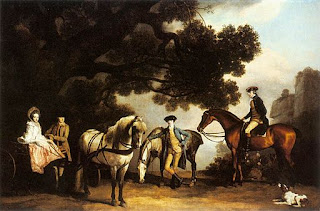The name of George
Stubbs (1724-1806) will always be linked to paintings of horses, of which he
was possibly the greatest ever exponent. However, his genius extended in equal
measure to the portrayal of people, and he should be ranked along Gainsborough
and Reynolds as one of the greatest portraitists of his age.
Born in Liverpool on 25th August 1724, George Stubbs
followed his father’s trade as a currier (a worker in leather goods) while also
teaching himself to draw and later to paint. He studied human anatomy,
including the dissection of corpses, before he moved on to his more well-known dissection
work on horses. These studies were central to his ability to portray horses and
people alike with an accuracy that had never been seen before and rarely since.
His painting
entitled “The Milbanke and Melbourne Families” was created in about 1770 and
was probably commissioned by Sir Penistone Lamb who later became 1st
Viscount Melbourne and the father of William Lamb, 2nd Viscount
Melbourne, who served as Prime Minister during the early years of the reign of
Queen Victoria and after whom the city of Melbourne (Victoria, Australia) is
named.
Sir Penistone served in Parliament for 40 years, but he made no impression as a politician,
only making one speech during his entire career as a politician, being far more
interested in his horses and in gambling. The brains and ambition inherited by
his son came from the latter’s mother, not his father.
The painting “The
Milbanke and Melbourne Families” serves to illustrate these circumstances very
well. It shows four people, three horses and two dogs, set against a typical
outdoor background (which is quite likely to be an invented one and which was
used by Stubbs for at least one other group portrait).
To the right
of the group is Sir Penistone, mounted on a chestnut horse that is seen in left
profile as the rider looks across at his wife, the former Elizabeth Milbanke,
who is seated in an open four-wheeled light one-horse carriage known as a
“tim-whisky”. Leaning on the carriage is her father, Sir Ralph Milbanke, who
was the head of an old Yorkshire family and
who, having lost his wife, had lately retired from Parliament.
The fourth
portrayal is of Elizabeth
Of the three
horses, the most splendid is undoubtedly that ridden by Sir Penistone.
Presumably one of his favourite hunters, it stands showing its conformation to
full effect, with neck arched gracefully forwards and coat gleaming with
health. The horse is of much more interest than its rider, who is in no way
flattered by the artist, Sir Penistone’s large nose being prominently featured.
However, the
viewer’s attention is taken by the lady in the picture, Elizabeth Milbanke. She
had married Sir Penistone at the age of sixteen and so would only have been
about seventeen at the time of the painting. She was energetic, level-headed,
rational and ambitious, all of which characteristics were lacking in her
husband. In later life she would use her beauty and her talents to good effect,
for example obtaining her husband’s viscountcy by sleeping with the Prince of
Wales. She was much admired by many leading figures of her day, including Lord
Byron who described her as “'the best friend I ever had in my life and the cleverest
of women'”.
Stubbs seems
to have caught much of her character in this portrayal. She is dressed in a
light-coloured shawl and pink dress, the folds of which fall from the carriage.
The brightness of her face and clothing contrast sharply with the dark
background and draw the viewer’s eye in her direction. In response, her eyes
are looking out at the viewer and nowhere near her husband or family members.
Although the
carriage horse stands still, Elizabeth
Stubbs is
certainly not alone among portrait artists in being able to convey much more
meaning than might be gathered at first glance. Gainsborough was certainly capable of this, as was Holbein from a previous era. Like Gainsborough, Stubbs
came from a modest background and was not averse to telling his aristocratic
employers what he really thought of them, in ways that they would have been too
stupid to appreciate for themselves.
The
apparently casual arrangement of four people and three horses conveys a very
strong message for those willing to read it, which is that here is a woman who
will make or break you, and quite possibly she will do both.
“The Milbanke
and Melbourne Families” was acquired by the National Gallery (London
© John
Welford

No comments:
Post a Comment